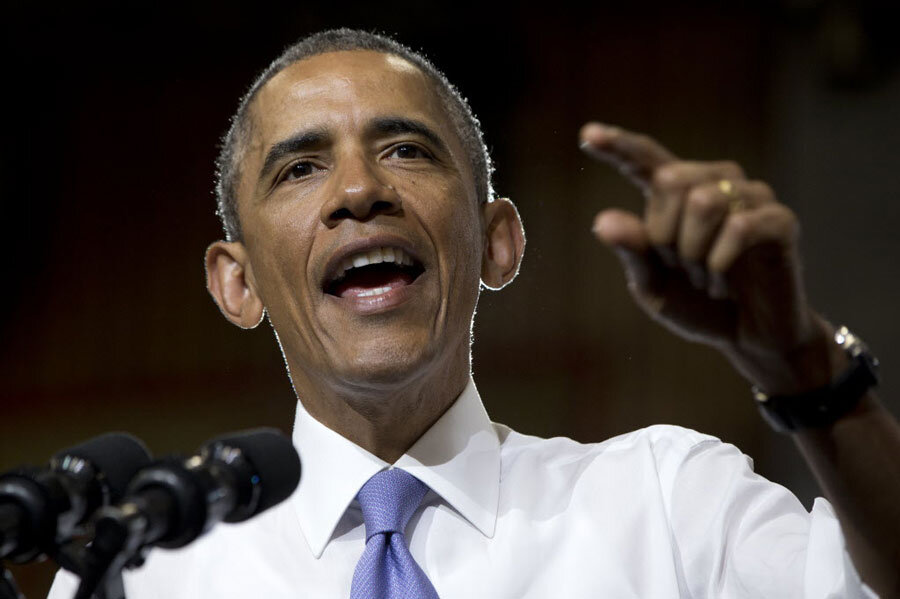Obama cutting mortgage fees for FHA borrowers: Good news for housing market?
Loading...
| Washington
The Obama administration is reducing mortgage-insurance fees that promises to make home loans more accessible to first-time home buyers – a move that could boost the housing market but with some potential risks to US taxpayers.
Insurance premiums will drop for new Federal Housing Administration loans, cutting the average FHA borrower’s mortgage payments by about $900 a year, the White House says.
At the margins, the lower-cost loans could help more Millennials enter the housing market. And by extension, that could prompt builders to boost home construction modestly as well. The change also might prompt some borrowers to refinance into new FHA loans so they can reap the lower mortgage costs.
FHA loans currently account for about 15 percent of new mortgages, a sizable chunk that’s heavy on low-income households and first-time buyers. The insurance premiums cover the cost of loans that go bad, and the administration says the FHA program will remain financially sound.
President Obama touted the shift in a speech Thursday in Phoenix – a city that saw some of the best of an epic housing boom a decade ago and the worst of a housing bust that followed.
“Over time, this is going to potentially have an impact over millions of families all across the country,” Mr. Obama said. “It should help further accelerate growth in the housing market.”
A White House fact sheet framed the change as part of broader efforts to ensure that creditworthy borrowers have access to loans.
But the fact sheet avoided an “ownership for all” tone, adding that Obama’s policy is also to “increase access to sustainable rental housing for families not ready or wanting to buy a home.”
Some critics of the change, however, say Obama’s latest move runs the risk of destabilizing the housing market again and putting taxpayers on the hook.
“It was just two years ago that taxpayers had to bail out the FHA to the tune of $1.7 billion,” Jeb Hensarling, the Republican who chairs the House Financial Services Committee, said in a statement released Wednesday. “The American people want an end to the destructive cycle of boom, bust and bailout that poor decisions in Washington produce.”
Similarly, finance experts Charles Calomiris and Stephen Haber argue that easy-credit policies are unstable for both the households who are enticed to borrow and for the financial system as a whole. They note that the Obama administration also has recently lowered underwriting standards for other government-chartered home loan programs (those backed by Fannie Mae and Freddie Mac).
Some Fannie Mae or Freddie Mac loan guarantees now will be available to borrowers who make down payments as low as 3 percent of the home’s purchase prices. For FHA-insured loans, down payments can be as little as 3.5 percent of the purchase price.
Together, the FHA, Fannie, and Freddie account for about 73 percent of new home loans. The other big category is bank loans where the risk of default is shouldered by the banks themselves.
But other housing experts don’t see the seeds of a new crisis being sown.
“The federal government’s home mortgage insurance program is finally back in the black, having improved materially over the past year,” writes Laurie Goodman and colleagues at the Urban Institute’s Housing Finance Policy Center. By the center’s analysis, the FHA “can significantly lower its premiums—charging current borrowers more appropriately for their risks — while continuing to build the necessary reserves against future losses.”
When a lender issues an FHA-insured loan, the premiums paid by borrowers go into a fund. Lenders are paid off by the fund if the loan defaults.
The Obama administration says the FHA program is following prudent lending standards developed after the 2008 crisis. Insurance premiums will still be 0.85 percent of the loan value per year, substantially higher than the pre-crisis norms of about 0.55 percent.
The White House projects that 800,000 borrowers will be able to take advantage of the lower premiums within a year, and that its new policy will nudge many families off the sidelines and into the home-buying market.
Since 2008, the housing market has gradually recovered. But many younger households, in particular, have remained in the rental market or have doubled up with parents rather than trying to buy homes. A key factor is affordability, so anything that cuts the cost of mortgages might help promote a long-expected revival of the first-time buyer.
Economists at the investment firm Goldman Sachs estimate that the lower insurance premiums could expand the FHA’s share of the overall mortgage market, by drawing in more borrowers.
And by boosting overall demand for homes modestly, the move might give a small boost to home building. The Goldman Sachs analysts say this could mean foundations are poured for an extra 14,000 homes, on top of the firm’s forecast for about 1 million housing starts this year.
The FHA news still leaves a major piece of housing policy up in the air: the regulatory future of Fannie Mae and Freddie Mac.
These corporations have a Congress-created charter, offering loan guarantees that cover much of the mortgage market. But these “government sponsored enterprises” were taken into federal conservatorship during the housing crisis, and Obama and Congress haven’t yet agreed on how to reform them.








